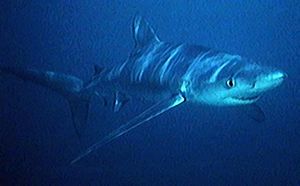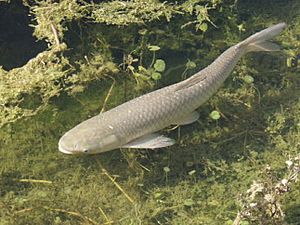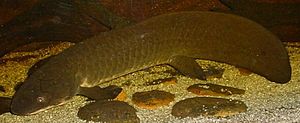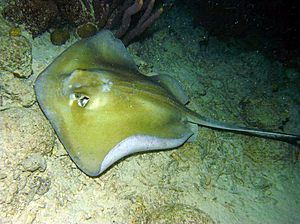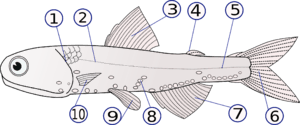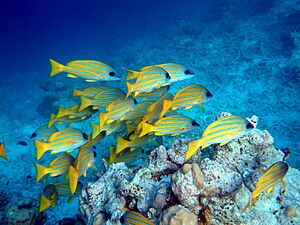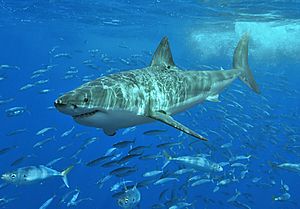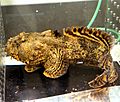Fish facts for kids
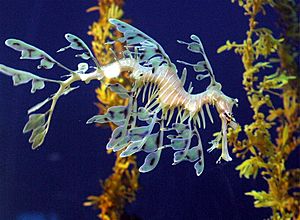
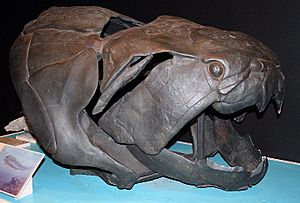
Fish are amazing animals that live in water. They are vertebrates, which means they have a backbone, just like humans! Fish breathe using special organs called gills, which help them take oxygen from the water. Unlike us, they don't have arms or legs with fingers and toes.
The word "fish" used to describe one main group of animals. But now, scientists know that the term "fish" actually covers five different groups of water-dwelling vertebrates:
There are more types of fish than all land animals with backbones (called tetrapods) combined! We know of over 33,000 different kinds of fish. Most fish have scales covering their bodies and use fins to swim. Most fish are also cold-blooded, meaning their body temperature changes with the water around them.
Fish live in all sorts of water, from fresh water in lakes and rivers to salt water in the ocean. Some fish are super tiny, less than one centimeter long. The biggest fish is the huge whale shark, which can grow almost 15 meters long and weigh 15 tons! Most fish always stay in the water. But some, like the lungfish, have developed lungs. This helps them survive when their rivers or pools dry up. They can burrow into the mud and wait for the water to return.
Contents
Fish or Fishes?
It can be tricky to know when to say "fish" or "fishes." Here's a simple way to remember:
- Fish is used when you're talking about one fish, or a group of fish that are all the same kind (species). For example, "I caught one fish," or "There are many fish in this pond."
- Fishes is used when you're talking about a group of different kinds (species) of fish. For example, "The aquarium has many different fishes from all over the world."
Types of Fish
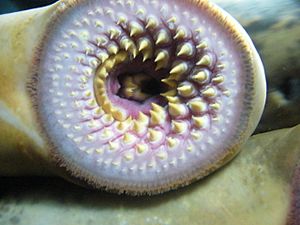
Fish are the oldest group of animals with backbones, first appearing about 490 million years ago! Here are the main types:
- Jawless fish (Agnatha): These are the oldest fish. They don't have jaws! Lampreys are an example of living jawless fish.
- Jawed fish (Gnathostomata): Most fish you know have jaws. This group includes:
- Armored fish (Placodermi): These are extinct fish that had heavy armor.
- Cartilaginous fish (Chondrichthyes): These fish, like sharks, rays, and skates, have skeletons made of soft cartilage instead of bone.
- Spiny sharks (Acanthodii): These are extinct fish that had spines.
- Bony fish (Osteichthyes): This is the largest group of fish, with skeletons made of bone. They include:
- Ray-finned fish (Actinopterygii): Most modern fish, like sturgeons, gars, and teleosts (which are the most common fish today), belong to this group. Their fins are supported by bony rays.
- Lobe-finned fish (Sarcopterygii): These fish have fleshy, lobed fins. This group includes lungfish and Coelacanths. Scientists believe land animals (tetrapods) evolved from ancient lobe-finned fish!
It's important to know that some animals with "fish" in their name are not actually fish! For example, Crayfish are crustaceans (like crabs), and jellyfish are Cnidarians (like sea anemones). Also, animals like whales and dolphins look like fish but are actually mammals.
Fish Anatomy
Bony and Cartilaginous Fish
Most fish have skeletons made of bones. These are called bony fish. But some fish, like sharks and rays, have skeletons made of a softer, flexible material called cartilage. These are known as cartilaginous fish.
Gills
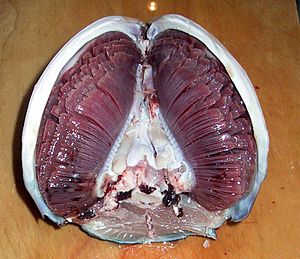
Most fish breathe using gills, which are located on the sides of their heads. Gills have many tiny, thread-like parts called filaments. These filaments are full of tiny blood vessels, creating a large surface area to absorb oxygen from the water and release carbon dioxide.
Fish breathe by pulling oxygen-rich water into their mouths and then pumping it over their gills. The blood in the gills flows in the opposite direction to the water. This helps the fish take in as much oxygen as possible. After the oxygen is absorbed, the fish pushes the oxygen-poor water out through openings near the gills.
Some fish, like sharks and lampreys, have several gill openings. But most bony fish have just one gill opening on each side. This opening is covered by a protective bony flap called an operculum.
Fish Scales

Almost all fish are covered with overlapping scales. Different types of fish have different kinds of scales. Modern fish (teleosts) have "leptoid" scales. These scales grow in circles and overlap like roof tiles, pointing from head to tail. This smooth arrangement helps the fish move easily through water.
Sharks and other cartilaginous fish have "placoid" scales. These scales are like tiny versions of their teeth! They also overlap from head to tail, making the shark's skin feel rough, like sandpaper. Shark skin can even be used as a special leather called shagreen.
Fish scales are usually covered with a layer of slime. This slime helps the fish glide through the water more easily and makes them slippery, which can help them escape from a predator.
How Fish Swim
Fish swim by pushing against the water around them. Most fish do this by wiggling their bodies and tails from side to side. They use strong muscles on each side of their body to create waves that travel from their nose to their tail. These waves get bigger as they move down the body, pushing the fish forward.
Some fish, especially those living in places like coral reefs, use their other fins (like the ones on their sides or top) more for movement. This helps them turn and move in tight spaces, but it means they can't swim as fast as fish that use their whole body and tail.
Fish Muscles
Fish have two main types of muscles for swimming:
- Red muscle: This muscle helps fish swim slowly for a long time. It's good for endurance.
- White muscle: This muscle is used for short, fast bursts of speed. Fish use it to chase prey or escape danger quickly.
Swimming in Groups
Many fish like to swim together in groups. When fish swim together in a very organized way, all moving in the same direction, it's called "schooling." If they are just casually grouped together, it's called "shoaling." Swimming in groups can help fish find food, protect themselves from predators, and even swim more efficiently.
Fish Body Shapes
The shape of a fish's body is very important for how it swims. A smooth, "streamlined" body helps the fish move through water with less drag, making it faster and more efficient. Here are some common fish shapes:
Streamlined (Fusiform)
The shape of a shark is called "fusiform." It's like a torpedo or a rocket, pointy at both ends. This is the best shape for swimming very fast through water. Fish with fusiform shapes, like marlins, swordfish, and tuna, are often found in the open ocean and swim constantly. It's interesting that other fast-swimming animals, like Ichthyosaurs (ancient marine reptiles), porpoises, and dolphins, have very similar shapes. This is an example of convergent evolution, where different animals develop similar features because they live in similar environments.
Eel-like
Fish like eels have long, ribbon-like bodies. This shape helps them hide in small cracks and holes. They can quickly dart out to catch food and then quickly return to their hiding spot.
Flatfish
Flatfish, like flounders, live on the bottom of the ocean or lakes. Their bodies are very flat, and as they grow, both of their eyes move to one side of their head! Most flatfish are masters of camouflage. They can change their colors to perfectly match the sand or rocks on the seafloor, making them almost invisible to predators and prey.
Compressed
Fish with "compressed" shapes have bodies that are flat from side to side, like a pancake standing on its edge. They swim upright and can be very thin. These fish often live in reefs, where their flat bodies allow them to easily slip in and out among corals, sponges, and rocks. This helps them stay hidden from predators. Examples include angelfish, surgeonfish, and butterflyfish.
Why Fish are Important to Humans
Fish as Food and Business

For thousands of years, humans have eaten fish as an important food source. Most fish we eat are caught from the wild. But "aquaculture," or fish farming, is becoming more and more common. Fish farming has been practiced in China since about 3,500 BCE!
Fish provide a huge amount of protein for people around the world. In some countries that rely heavily on the sea, fish can provide a very large part of people's diet. Fish are also a big part of trade and business.
Catching fish for food or fun is called fishing. The organized effort to catch fish for business is called a fishery. Fisheries are a massive global industry, providing jobs and income for millions of people. Each year, about 154 million tons of seafood are caught worldwide. Popular types include herring, cod, anchovy, tuna, flounder, and salmon. The term "fishery" also includes catching other seafood like mollusks (like clams) and crustaceans (like shrimp), which are often called "fish" when used as food.
Fish for Fun and Beauty

Fish have been admired for their beauty for a very long time. They appear in ancient cave art. People also raise ornamental fish in ponds, like Koi, or keep them in aquariums in their homes, offices, or public places.
"Recreational fishing" is fishing just for pleasure or in competitions, not for selling the fish. The most common way to do this is with a rod, reel, line, hook, and bait. People who fish this way are called "anglers." Anglers need to choose the right hook, cast their line carefully, and reel it in at the right speed. They also think about the water, weather, type of fish, and time of day.
Fish in Culture
Fish are often seen in art, books, and movies. Think of movies like Finding Nemo or books like The Old Man and the Sea. Large fish, especially sharks, have been the stars of many exciting films, like Jaws, which led to other movies and cartoons like Shark Tale.
In the Book of Jonah from the Bible, a "great fish" swallowed Jonah the Prophet. Legends of half-human, half-fish mermaids have been told for centuries, including in stories by Hans Christian Andersen.
Fish also have special meanings in many religions. Christians often use the fish as a symbol for Jesus or Christianity. In Buddhism, fish symbolize happiness and freedom because they can move freely in the water. In some cultures, carp are seen as sacred because of their beauty and long lives. Many gods and goddesses are said to have taken the form of a fish, like Ika-Roa for Polynesians, Dagon for some ancient people, and Matsya for Hindus.
The astrological sign Pisces is based on a constellation of two fish in the night sky.
Fish as Pets
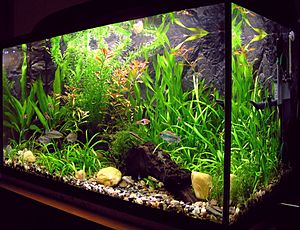
Many people enjoy keeping fish as pets. Popular pet fish include Goldfish and Siamese Fighting Fish. Large, beautiful fish like Koi are often kept in public ponds for their calming nature and beauty.
| Vertebrates |
|---|
| Amphibian • Bird • Fish • Mammal • Reptile |
Images for kids
-
Lower jaw of the armored fish Eastmanosteus pustulosus, showing its strong "teeth"; from the Devonian period.
-
Leedsichthys, was one of the largest fish ever, possibly up to 16 meters long!
-
The colorful mandarin dragonet is one of the few animals with blue coloring from special cells.
-
The amazing diversity of fish groups (and other vertebrates) throughout history.
-
The bowfin Amia calva is the only survivor of its ancient fish group.
-
Inside a fish: 1. Liver, 2. Gas bladder, 3. Roe (eggs), 4. Pyloric caeca, 5. Stomach, 6. Intestine.
-
Top view of the brain of a rainbow trout.
-
The swim bladder of a rudd (Scardinius erythrophthalmus), which helps the fish control its buoyancy.
-
French grunts – Haemulon flavolineatum.
-
Whale sharks, the largest species of fish, are considered vulnerable.
-
A fish counter display at the Oulu Market Hall in Oulu, Finland.
-
These goldband fusiliers are schooling because their swimming is synchronized.
-
Actinopterygii (Brown trout).
-
Sarcopterygii (Coelacanth).
-
Egg of lamprey.
-
Egg of bullhead shark.
-
Egg of chimaera.
See also
 In Spanish: Pez para niños
In Spanish: Pez para niños


